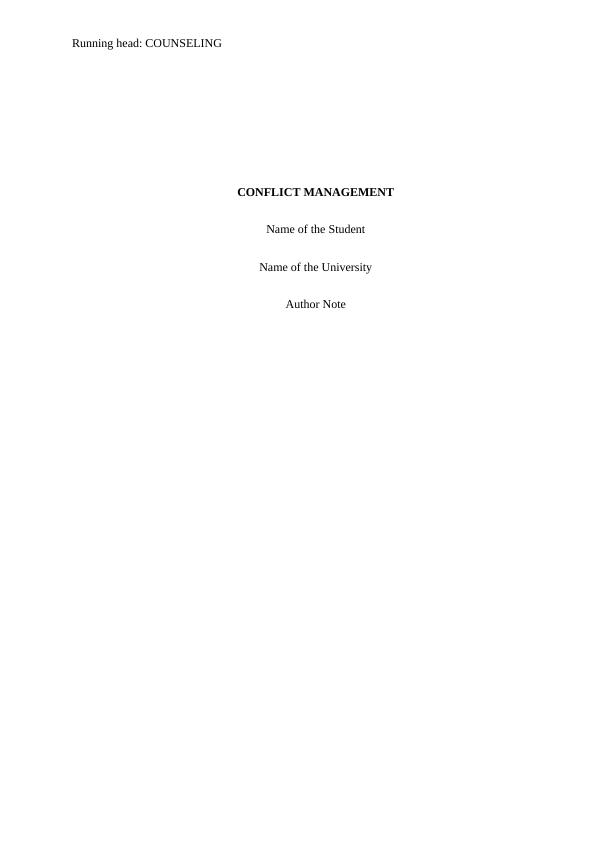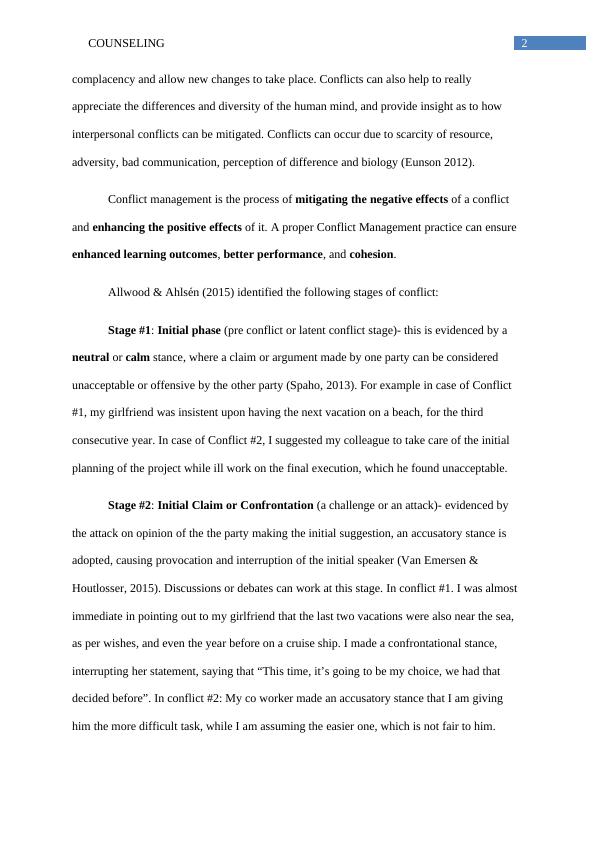Conflict Situations in the Classical T-Theory
Added on 2020-04-15
10 Pages2654 Words166 Views
Running head: COUNSELING CONFLICT MANAGEMENTName of the StudentName of the UniversityAuthor Note

1COUNSELINGConflict Situation #1: Conflict with my girlfriend regarding where to spend the vacation.Conflict Situation #2: Conflict with my colleague regarding a project which is to be worked upon by both of us, regarding the distribution of responsibilities to complete the work.The Classical Theory of Conflict was proposed by Karl Marx, pointing out that class consciousness against oppression causes social conflicts. However modern theories by C Wright Mills points out that: A) conflicts are influenced by unequal sharing of resources and power in the society. B) Integration between the elite powers of the government (thereby increasing their power), both of which can result in an escalation of conflict.Conflict can be understood as a type of disagreement/ argument/ incompatibility ofopinions, principles or interest, causing dissonance within a group. Or a situation the actions or beliefs adhered to by individual(s) are are deemed unacceptable or are resisted byothers. Conflicts can be either Interpersonal, Intra Group or Inter Group. The conflicts can often foster the feeling of hatred (Mas & Dijkstra, 2014).Eunson (2012), suggests that conflict can have both positive and negative effects. The obvious negative effects are formation of negative emotions, communication blocks or failures, stereotyping of people (with whom the conflict is), a reduction in coordination, shift towards autocracy and an impaired ability to empathize, and understand the perspectives of others. The positive effects are that it allows the release of vent up emotions, help to form new perspectives from the opposing side or from the same side, this can help in better decision making and problem resolution skills which can in turn improve cohesion, challenge

2COUNSELINGcomplacency and allow new changes to take place. Conflicts can also help to really appreciate the differences and diversity of the human mind, and provide insight as to how interpersonal conflicts can be mitigated. Conflicts can occur due to scarcity of resource, adversity, bad communication, perception of difference and biology (Eunson 2012).Conflict management is the process of mitigating the negative effects of a conflict and enhancing the positive effects of it. A proper Conflict Management practice can ensure enhanced learning outcomes, better performance, and cohesion.Allwood & Ahlsén (2015) identified the following stages of conflict:Stage #1: Initial phase (pre conflict or latent conflict stage)- this is evidenced by a neutral or calm stance, where a claim or argument made by one party can be considered unacceptable or offensive by the other party (Spaho, 2013). For example in case of Conflict #1, my girlfriend was insistent upon having the next vacation on a beach, for the third consecutive year. In case of Conflict #2, I suggested my colleague to take care of the initial planning of the project while ill work on the final execution, which he found unacceptable.Stage #2: Initial Claim or Confrontation (a challenge or an attack)- evidenced by the attack on opinion of the the party making the initial suggestion, an accusatory stance is adopted, causing provocation and interruption of the initial speaker (Van Emersen & Houtlosser, 2015). Discussions or debates can work at this stage. In conflict #1. I was almost immediate in pointing out to my girlfriend that the last two vacations were also near the sea, as per wishes, and even the year before on a cruise ship. I made a confrontational stance, interrupting her statement, saying that “This time, it’s going to be my choice, we had that decided before”. In conflict #2: My co worker made an accusatory stance that I am giving him the more difficult task, while I am assuming the easier one, which is not fair to him.

End of preview
Want to access all the pages? Upload your documents or become a member.
